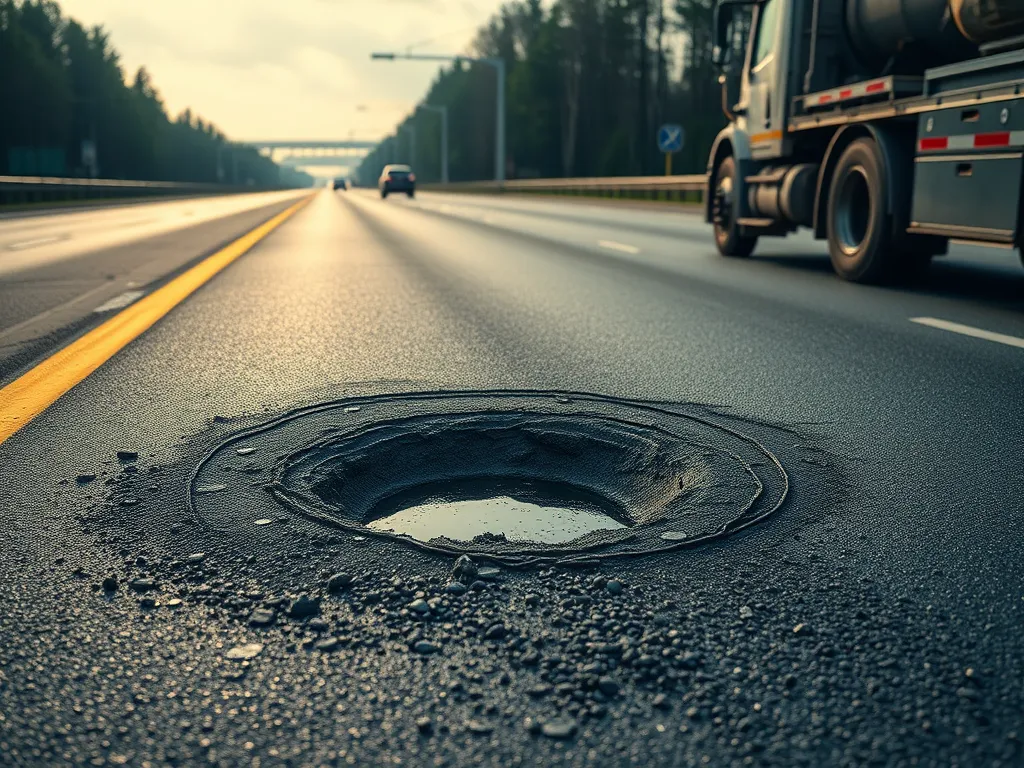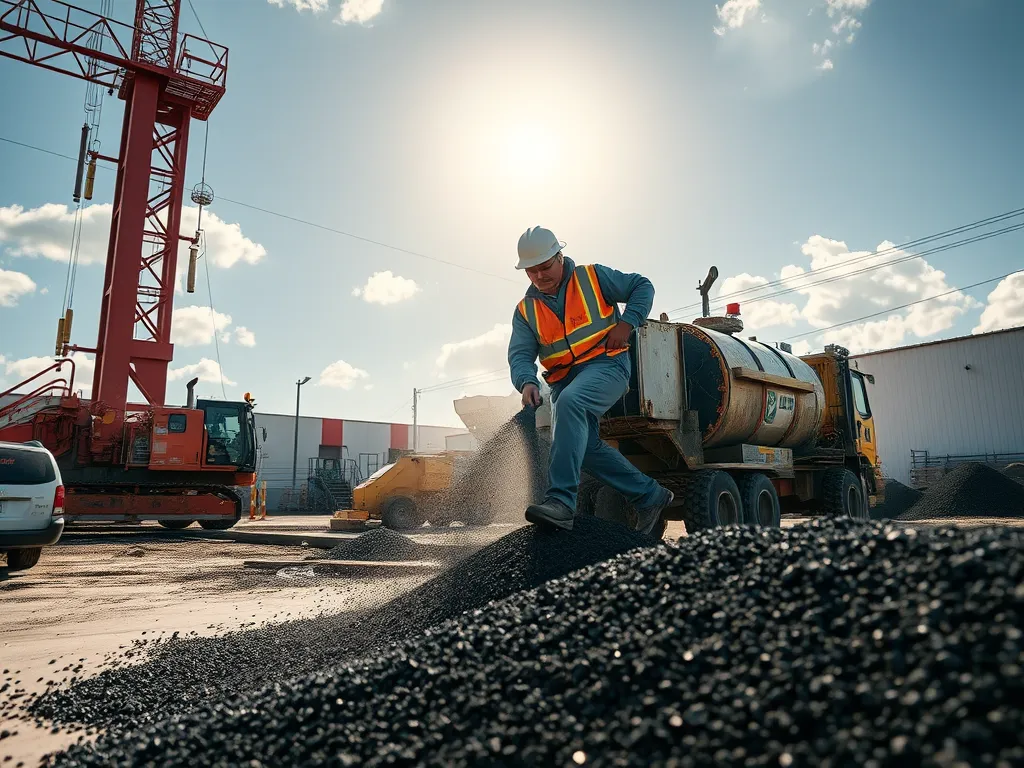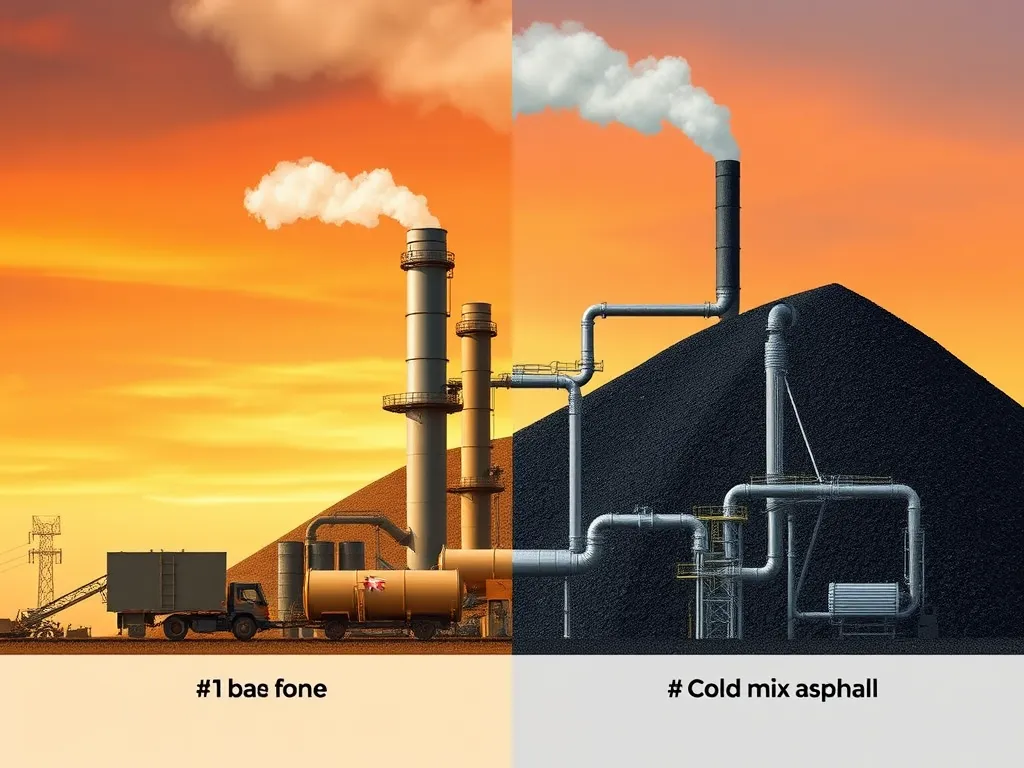Cold Mix Asphalt Vs Other Patching Materials: Which Should You Choose?
Published on: October 15, 2025 | Last Updated: April 14, 2025
Written By: George Voss
Cold mix asphalt is a ready-to-use patching material made with unheated aggregates and emulsified asphalt binder, offering year-round repair capabilities without heating—unlike hot mix asphalt or concrete. It provides faster fixes for potholes and cracks compared to hot mix (requires 300°F temperatures) or concrete (needs 24-48 hours curing), but lasts 6-18 months versus 5-8 years for hot mix. Key differences include lower upfront costs ($0.15-$0.40 per pound vs $120-$200 per ton for hot mix), easier DIY application, and 90% recyclability.
This guide compares cold mix asphalt to seven common alternatives: hot mix asphalt, concrete patching compounds, urethane sealers, infrared patches, epoxy fillers, gravel, and recycled asphalt. We analyze cost per square foot, durability under traffic loads (up to 5,000 vehicles/day), seasonal limitations, and environmental impacts. Data includes ASTM material specifications, curing times (from 20 minutes to 7 days), and repair lifespans across climates.
Contents
- What is Cold Mix Asphalt?
- Advantages Of Cold Mix Asphalt
- Disadvantages Of Cold Mix Asphalt
- Cold Mix Asphalt Vs Hot Mix Asphalt
- Cold Mix Asphalt Vs Other Patching Materials
- Cost Comparison Of Patching Materials
- Cold Mix Asphalt Specs
- Environmental Considerations
- Ease Of Use and Fix Steps
- Frequently Asked Questions (FAQ)
- Closing Thoughts
- Additional Resources for You:
What is Cold Mix Asphalt?
Cold mix asphalt fills cracks and holes without heat. It stays workable in cold temps and costs less than heated options. Builders keep it on hand for quick fixes year-round.
Definition Of Cold Mix Asphalt
Cold mix asphalt is a road fix blend used when heat isn’t an option. Made with rocks, sand, and sticky binder (bitumen) held by special liquids. Unlike hot mix, it sets at air temp. No plant heating needed—just pour, pack, and drive.
Types Of Cold Mix Asphalt Materials
Four main types handle different needs. Emulsion-based uses water and soap to bind bits—works in wet or cold. Cutback blends have oil thinners for faster curing. Polymer-modified adds plastic to boost grip and stop cracks. Recycled cold patch mixes old asphalt chunks (RAP) with new binder, cutting costs by 15-30%.
These types shape how cold stack up against other fixes. Next, see why pros pick it for speed and ease.
Advantages Of Cold Mix Asphalt
Cold mix asphalt stands out as a versatile solution for road maintenance. Its unique properties make it a go-to choice for specific repair scenarios where traditional materials fall short.
Ease Of Application in All Seasons
Cold mix asphalt works in temperatures from 20°F to 120°F. Unlike hot mix asphalt, which requires heating to 300°F during production, cold patch material remains pliable without heat. This allows winter pothole repairs when hot mix plants shut down. Contractors can stockpile bags for sudden freeze-thaw damage without worrying about material hardening.
No Specialized Equipment Required
Repairs need only basic tools: a shovel, tamper, and compactor. Hot mix asphalt demands heavy machinery like pavers and rollers, adding $150-$300 per hour in equipment costs. Cold mix simplifies small-scale jobs – open the bag, fill the hole, and compact. This DIY-friendly approach makes it ideal for homeowners tackling driveway cracks or municipalities addressing minor road defects.
Immediate Use for Emergency Repairs
Cold patch asphalt cures through traffic compression rather than heat. Vehicles can drive over repairs instantly, unlike concrete patches needing 24-48 hours to set. Emergency crews use it to temporarily fix hazardous potholes on highways within minutes. A 12″x12″ repair typically takes 15 minutes versus 3+ hours for infrared asphalt patching methods.
These benefits position cold mix as a practical option for time-sensitive, low-traffic repairs. Yet its performance varies significantly compared to permanent solutions – a reality explored in the following section.

Disadvantages Of Cold Mix Asphalt
While cold patch asphalt works for fast fixes, its limitations impact long-term road repair plans. Let’s analyze critical drawbacks to factor into material choices.
Limited Durability in High-traffic Areas
Cold mix asphalt lacks structural strength for roads with 1,000+ daily cars. Traffic load tolerance tops out at 3,000 lbs per axle (AASHTO M323 standards), far below hot mix’s 15,000 lb capacity. Binding agents in cold patch materials—like PG 58-28 asphalt cement—don’t fully integrate with existing pavement. This leads to rutting or crumbling within months on busy roads.
Potential for Water Infiltration Over Time
Air voids in cold mix average 8-12% (ASTM D4867), double hot mix’s 4-6%. Moisture seeps into gaps during rain, freezing into ice that widens cracks. Without heat to seal voids, water weakens bonds between aggregate and bitumen. Annual raveling rates jump 15% in humid climates, requiring 2-3x more upkeep than infrared or hot mix repairs.
Shorter Lifespan Compared to Hot Mix
Cold patch asphalt lasts 1-2 years vs hot mix’s 7-10 year span. Ambient curing slows bitumen activation, limiting compaction to 92-95% density. Weak bonds allow oxidation, causing surface degradation 40% faster. Budget $0.85-$1.20 per sq ft for cold mix vs $2.50-$4.00 for hot mix, but factor in 3x more frequent reapplications.
Looking at how cold mix asphalt stacks up against hot mix in production and application reveals critical trade-offs for project planning.
Also See: Asphalt Skid Resistance Standards: A Safety Overview
Cold Mix Asphalt Vs Hot Mix Asphalt
Choosing between cold mix and hot mix depends on project needs, weather conditions, and traffic demands. Both serve distinct roles in road maintenance with unique benefits.
Key Differences in Production and Application
Cold mix uses emulsified bitumen blended with aggregates at ambient temperatures. No heating needed. Hot mix requires heating aggregates and PG binders to 280-325°F before mixing. This makes cold mix ready for immediate use from the bag, while hot mix needs specialized spreaders and rollers. Cold patch works for temporary fixes; hot mix forms permanent surfaces through thermal bonding.
Durability and Longevity Comparison
Hot mix withstands heavy traffic for 7-15 years due to tight molecular bonds formed during heating. Cold mix lasts 6-12 months before needing rework, with lower PSI ratings (1,500 vs 3,500+ for hot mix). High-traffic zones degrade cold patch 60% faster. Freeze-thaw cycles split cold mix surfaces twice as often.
Temperature and Seasonal Limitations
Hot mix requires ground temps above 40°F for proper compaction. Cold mix sets in freezing conditions (-20°F to 120°F). Summer heat softens cold patch temporarily, while winter repairs stay stable. Hot mix loses workability within 90 minutes; cold mix remains pliable for months if sealed.
While temperature tolerance defines their use cases, material costs tell another story. Let’s examine how pricing impacts repair decisions.

Cold Mix Asphalt Vs Other Patching Materials
Cold Patch Asphalt Vs Concrete Patching
Cold patch asphalt offers instant repairs in any weather, while concrete patching requires curing times of 24-48 hours. Concrete excels in durability (20+ years vs. cold patch’s 1-2 years) for high-traffic zones like highways. Cold patch costs $2-$4 per square foot versus concrete’s $4-$8, making it ideal for temporary fixes on driveways or rural roads. Concrete’s rigidity resists heavy truck loads but cracks under freeze-thaw cycles without expansion joints.
Cold Mix Vs Urethane-based Sealers
Urethane-based sealers bond tightly to existing asphalt, sealing cracks as narrow as 1/8 inch. They cure in 2-4 hours but cost $0.50-$1.50 per linear foot. Cold mix fills potholes up to 6 inches deep, needing 24 hours to harden fully. Urethane flexes with temperature shifts (-40°F to 180°F), while cold patch can ravel under repeated tire stress. Use urethane for hairline cracks; choose cold mix for structural repairs.
Cold Patch Vs Infrared Patching Methods
Infrared patching heats existing asphalt to 300°F, blending new material seamlessly. This method repairs areas up to 50 sq ft in 30 minutes, lasting 5-7 years. Cold patch requires no equipment, works for spots under 4 sq ft, but may need reapplying annually. Infrared costs $8-$12 per square foot versus cold patch’s $2-$4. Municipalities favor infrared for busy intersections; homeowners pick cold patch for DIY curb repairs.
While performance factors matter, cost considerations often drive final decisions. Up next: breaking down material pricing and long-term value.
Cost Comparison Of Patching Materials
Material costs drive repair decisions. Cold mix asphalt often wins on upfront price, but full cost analysis requires weighing performance, labor needs, and lifespan across options.
Cold Mix Asphalt Cost Per Square Foot
Cold patch asphalt costs $0.15-$0.50 per square foot for standard repairs. Pre-bagged options (40-80 lbs) run $5-$25 per bag. Bulk purchases lower costs to $25-$60 per ton. Regional price swings occur based on RAP (Recycled Asphalt Pavement) content and additives like polymers.
Hot Mix Asphalt Vs Cold Mix Pricing
Hot mix asphalt averages $1.50-$3.00 per square foot. While 3-6x pricier than cold mix, it needs no repeated fixes in high-traffic zones. Factor in extra hot mix expenses: $200/hour for asphalt heaters, $150-$300 daily equipment rentals, and minimum order requirements (typically 2+ tons).
| Material | Cost/Sq Ft | Expected Lifespan | Best Use |
|---|---|---|---|
| Cold Mix | $0.15-$0.50 | 6 mo-2 yrs | Temp fixes, low-traffic |
| Hot Mix | $1.50-$3.00 | 7-12 yrs | Permanent repairs |
| Concrete | $3.00-$5.00 | 15-30 yrs | Structural repairs |
Long-term Cost Implications Of Different Materials
Cold mix asphalt repair saves money now but may cost more over 5 years. Example: A 10 sq ft pothole repaired annually with cold patch totals $75-$150. Hot mix done once: $45-$90. Infrared patching (blends old/new asphalt) costs $2.50-$4.00/sq ft upfront but lasts 3-5x longer than cold mix.
With durability and application factors clarified, let’s examine technical specs that determine performance across materials.
Cold Mix Asphalt Specs
Cold mix specs set it apart from hot mix and other fixes. These rules shape how it works in real-world use.
Material Make-up Needs
Cold mix uses 90-95% stone (3/4″ max size) plus 5-10% liquid bitumen. Additives like lime (1-3%) boost stick power. Unlike hot mix, it skips heating – bitumen stays thick until packed. Concrete patch needs cement paste (25-30%), making it stiff but slow to set.
Packing and Set Time Rules
Cold mix needs 95% density per ASTM D4215. Hand rammers work for small jobs; rollers handle big patches. Full cure takes 14-30 days. Urethane sealers set faster (2-4 hours) but cost 3x more. Hot mix hits full strength in 24 hours with steam rollers.
Weight Load Limits
Cold patch holds up to 5,000 axles/day when packed right. Hot mix handles 20,000+. Infrared fixes last 2-3x longer in truck lanes. For home drives (1-5 cars/day), cold mix works fine. Bus stops need hot mix or concrete.
These specs show why mix choice matters. Next, see how green factors tilt the scale.
Environmental Considerations
Cold mix asphalt offers clear green perks when stacked up against hot mix or other patch options. Its low-heat needs and reuse rates make it a top pick for earth-first jobs.
Energy Efficiency Of Cold Mix Production
Cold mix skips the heat. Hot mix needs 300°F temps, burning 25-35 gallons of fuel per ton. Cold mix uses 90% less energy – just mix and go. No kilns like cement needs. No melt tanks like plastic-based sealers. This cuts power bills by $8-$12 per ton versus hot mix.
Recyclability Of Asphalt Materials
Asphalt beats most patch stuff for reuse. Cold mix can hold 30-50% RAP (old ground-up pavement). Full recycling happens at plants – 99% gets reused. Compare to cement patches: only 10% recycled content. Urethane sealers? Zero recycle rates once set.
Emissions Comparison With Hot Mix Processes
Hot mix plants pump out 22 lbs CO2 per ton. Cold mix makes 5 lbs. That’s 17 lbs saved – like a car driving 18 miles. Less fumes too: hot mix lets loose VOCs at 2.5 grams per ton. Cold mix stays below 0.5 grams. No black smoke or burnt rock smells.
With green perks clear, let’s break down how each patch type handles real road work…

Ease Of Use and Fix Steps
Patch work varies by mix type. Cold mix stands out for quick fixes with less hassle. Let’s break down key steps, time needs, and skill levels.
Steps to Prep for Cold Mix Fixes
Cold mix needs less prep work than most options. Just sweep the hole. No need for heat or dry ground. Pour, pack, and go. Hot mix asks for tack coats to bind. Must heat to 300°F. Concrete patches need forms built first. Let set for 1-2 days before use.
Time Needs by Mix Type
Cold patch works right away. Drive on it once packed. Hot mix takes 2 hours to set. Needs a roller truck for speed. Urethane sealers dry fast (30 mins) but cost 3x more. Concrete takes 24-48 hours to cure. Infrared repair melts old asphalt. Fix takes 20 mins but needs a pro crew.
DIY or Hire a Pro?
Cold mix is a top pick for DIY. Buy bags at stores. Use basic tools like a shovel. Save up to $5 per sq ft vs pros. Big jobs or high traffic zones may need pros. Infrared and hot mix need special gear. Urethane requires mixing guns. These methods add labor costs but last longer.
Ease and speed matter, but price points vary too. Let’s break down the numbers next.
Frequently Asked Questions (FAQ)
Can Cold Mix Asphalt Be Used in Winter?
Yes, cold mix asphalt can be used in winter conditions, making it a versatile choice for repairs even during cold weather. It remains workable at temperatures as low as 20°F, enabling repairs when hot mix plants are shut down due to cold.
How Long Does Cold Patch Last?
The lifespan of cold patch asphalt typically ranges from 6 months to 2 years, depending on various factors like traffic volume and climate conditions. Regular maintenance and reapplication may be necessary in high-traffic areas.
Is Cold Mix Suitable for Large Potholes?
While cold mix asphalt can effectively fill potholes, it is generally recommended for smaller repairs due to its limited durability in high-traffic areas. For larger or more structurally critical potholes, more permanent solutions like hot mix asphalt or infrared patching may be more appropriate.
Closing Thoughts
When evaluating cold mix asphalt against other patching materials, it’s crucial to weigh the specific needs of your project. Cold mix asphalt excels in ease of application and immediate usability, making it ideal for emergency repairs. However, consider its limitations in durability and lifespan, particularly in high-traffic areas.
Concrete patching offers strength but may not match the flexibility of cold mix for quick fixes. Urethane-based sealers provide excellent sealing capabilities, whereas infrared patching can restore road integrity with heat, but often requires more specialized equipment.
Ultimately, the best choice depends on your budget, traffic conditions, and repair timelines. For more insights into asphalt materials, check out Asphalt Calculator USA for comprehensive resources.
Additional Resources for You:
- The Asphalt Institute. (2007). MS-4: The Asphalt Handbook. Lexington, KY: Asphalt Institute.
- Hot Mix Vs. Cold Mix Asphalt: What’s The Difference?
- The Ultimate Guide to the Best Cold Patch Asphalt – Pavemade.com
- UPM® Cold Mix Asphalt Patch | Cold Patch Asphalt Repair | UNIQUE Paving Materials
- Hot Mix Asphalt Vs. Cold Patch Asphalt | EastCoat Pavement Services


